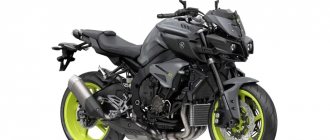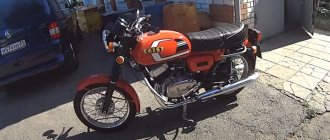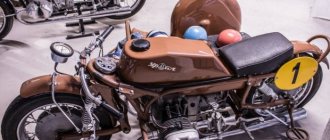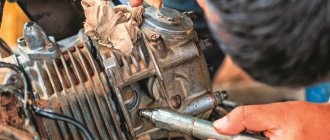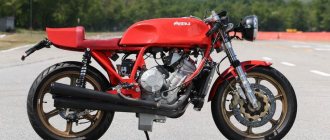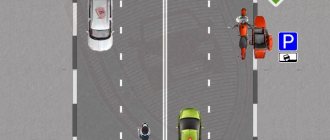There are many legendary motorcycles. The Americans will call you Harley-Davidson, the British - Royal Enfield, the Italians - Moto Guzzy... In the territory of the former post-Soviet space, which includes the countries of Eastern Europe, such a motorcycle is, of course, the Java 350.
Today, when you go to the company’s website, you can find modifications adapted to modern requirements, like the Jawa 350 Replica or Jawa 350 Premier. The legendary brand continues to be popular. But to understand the reasons for this popularity, you should turn to its origins and get to know Java better.
Forward movement
Few people know about this, but the history of a motorcycle with this name began back in 1934. The bike that appeared at that time was equipped with a single-cylinder engine with a power of 12 hp. s., four-speed gearbox, weighed 125 kg. and accelerated to a speed of 100 km/h. He participated in international competitions and won, proving his quality. It was called Jawa 350 SV.
The war made adjustments to the plans of the Czech manufacturer, and the model, which received the Java 350 type 12 index, appeared only in 1948. Due to certain circumstances, it did not last long on the assembly line. The wide Russian consumer had a chance to get acquainted with the next modification - Java 350 354/06, launched into production in 1954. It is this successful car that should be considered the first line in the success story of a popular brand in our country.
Pre-war beginning
Java motorcycles began their history back in the very distant 1920s. Then, in the Czechoslovak town with the specific name Tinetz nad Sazavou, the owner of the concern of the same name, Frantisek Janicek, entered into a deal with the German company Wanderer. It started with the mass production of motorcycles, but now moved on to the production of passenger cars. More space was required in the workshops, so the equipment that had previously worked on motorcycles was put under the knife, so to speak. It was also necessary to sell a whole warehouse of parts and spare parts that had already become unnecessary.
One of the first motorcycle samples
Janicek and his desire to expand his business could not have come at a better time. An agreement was concluded, Frantisek rubbed his hands contentedly. In Europe of those years, the two-wheeled motor companion was in use and in demand. But with the release of the first Java model, all the shortcomings of the deal came to the surface. The production of a motorcycle was expensive, so the price tag on the market was corresponding. But without any clear advantages over its competitors, it failed in sales. In three years, only a little over a thousand copies were sold.
Expert opinion
Isaac Yakovich Zelder
Soviet astrophysicist, physical chemist, Doctor of Physical and Mathematical Sciences, Academician of the USSR Academy of Sciences, designer, engineer. Hero of Socialist Labor of the USSR.
It was necessary to urgently take action to save the newly launched but already drowning motorcycle brand. The name itself, by the way, was invented very simply and no wonder - they took the first letter of the surname of the owner of the concern “Ya” and the first two letters of the German company that sold its technology - “Ba”. They were put together and the familiar “Java” came out.
In order to stay afloat and make a profit, it was decided to reduce the speed a little and produce simpler models. As a result - the “Java Robot” motorbike. It was he who allowed it to gain popularity in the European market. It was simple in design, relatively inexpensive, and because of its classification, there was no need to obtain a license or buy a license plate. In the first year, more copies were sold than the first “Java” for the entire period of its release. In total, about 15 thousand copies were purchased before the war.
Decent characteristics of Java 350
The bike, unlike its predecessors, received a two-stroke two-cylinder engine with a volume of 350 cc. cm, air-cooled. Power increased to 16 hp. s., and in later versions, after installing a new carburetor, up to 18 liters. With.
By the way, the Java 350 carburetor was subsequently modified several times. The maximum speed was 115 km/h (with a direct landing of the motorcyclist). The drum brakes worked reliably, and the front and rear forks with telescopic shock absorbers ensured comfortable movement on paved roads.
This became especially noticeable in 1958, when cone-type shock absorbers were replaced with piston ones. The voltage of the battery and generator used to operate the electrical equipment of the Java 350 motorcycle is 6 volts. Weight – 139 kg. Consumption, for that time, was very moderate - 3.6 liters.
The appearance of the model not only corresponded to the trends of the time, but was progressive and well thought out. It was the modification 354/06 that Viktor Tsoi was seated on by the author of the monument to the famous rock musician, Alexey Blagovestnov. As an element of a monumental composition, old Java looks very harmonious.
Rockers of the USSR: from “Java” to “Harley”
Against the backdrop of the inaccessibility of cars, the popularity of motorcycles in the USSR reached a truly epic scale. It is not surprising that the first “clubs of interest” were born in this environment, which eventually resulted in a mass movement of rockers that swept the entire country
Natalya Umnova
The biker movement originated in the USA in the 1950s and almost immediately became a “protest” movement, attracting “selected” youth who wanted freedom and new opportunities. In the USSR, after the Great Patriotic War, the “motorcycleization” of the country proceeded at an accelerated pace, but in a more peaceful direction: relatively inexpensive and accessible motorcycles became an everyday means of transportation for all ages and segments of the population, transportation of various goods, including building materials for dachas, travel equipment.
In the mid-60s, several factories produced motorcycles, mopeds and scooters - up to 350,000 IZhs per year - which were not much inferior in quality to their foreign counterparts. In the 1970s and 80s, it became easier to buy a car, and adults started driving cars. Motorcycles as a means of transport remained in the countryside, and in the cities they began to attract young people - just at this time, echoes of the biker movement from the USA reached the USSR.
However, in the Soviet Union, informal associations of young people on motorcycles were called “rockers” rather than bikers. This term appeared in the early 80s and denoted Soviet rock music fans who tried to copy the style of British “coffee bar cowboys” and American bikers. But since many fans of hard rock in large cities already rode motorcycles, the term “rocker” soon spread to young motorcyclists in general, and to members of the first domestic motorcycle clubs in particular.
But for the Soviet “rocker,” especially in the provinces, it was not so important what ordinary people called him. From adolescence, the guys helped their fathers fix their motorcycles, collected spare parts from landfills and built equipment themselves; many took part in free motocross and karting sections.
We gradually saved money and bought our own lightweight, relatively inexpensive, domestically produced motorcycles: “IZH Planet”, “IZH Planet Sport”, “Minsk”, “Voskhod”. In the 1970s and 80s, Voskhod cost 450 rubles. - this is 3-4 average salaries.
The motorcycle was unpretentious, economical, lightweight and repairable, although not particularly reliable. But many learned to repair internal combustion engines on it. “IZH Planet” already cost 625-750 rubles. (4-5 average salaries), but at the same time the cheapest car - "Zaporozhets" - was sold for 3000-3750 rubles.
"Sunrise"
"IZH Planet Sport"
There were also “foreign cars” in the Soviet motorcycle fleet. For example, Czechoslovakian Jawa motorcycles were supplied to the USSR from the mid-50s, and by the 70s almost every third motorcyclist rode them, and in total there were more than a million Jawas in the USSR, which were valued for their reliability, power, versatility and ease of use. maintenance and repair.
Jawa 350
The most fashionable model in the USSR was the Java-638, which began to be produced in 1984. It had a two-stroke two-cylinder engine with a volume of 343 cubic meters and a power of 26 hp. s., the maximum speed of the motorcycle was 120 km/h.
In addition to Jawa, Hungarian Pannonia motorcycles were popular, equipped with a single-cylinder 250 cc two-stroke engine, a four-speed gearbox, a closed chain drive and a duplex frame. From 1954 to 1975, 287,000 motorcycles of this brand were imported into the USSR. The most successful model was the Pannonia 250 TLF: the motorcycle weighed 146 kg, had an 18-liter tank, boasted reliable electrics, and its engine produced 18 hp. With. power. In addition to this model, the plant produced motorcycles with a 350 cc engine and a sidecar.
Pannonia
Another successful motorcycle of those years was the Czechoslovakian CZ - “Cheset”. The dream of an entire generation was produced since 1962 and was equipped with a single-cylinder two-stroke engine with a displacement of 250 cm3.
CZ 350
CZ Cross 250
But the “rocker” movement in the USSR was inextricably linked precisely with IZh motorcycles and the iconic Czechoslovak “Java”. In the cities, taxi drivers were the first to buy Java cars: in the 60-70s they earned 100-120 rubles. per month, depending on the class of the driver, and, in addition, they often sold vodka or counterfeit goods under the counter, having a considerable additional income. Taxi drivers were then in fashion with eight-piece caps and brown leather jackets, which they bought from military pilots. In the evenings after work, they got together with colleagues and rode motorcycles.
At that time it was not necessary to wear a helmet. But as the number of motorcycles grew, so did the number of accidents involving them, and then drivers were required to wear helmets. However, at first there were not enough helmets for everyone, and they were poor and made of iron. Such a “helmet” spoiled the dashing appearance of a motorcyclist on a “Java” - that’s when the division began into the 1% of hooligans who did not recognize helmets, prohibitions on crowd gatherings and traffic rules, and the remaining 99% of law-abiding motorcyclists. But over time, when more modern plastic helmets began to arrive from the Baltics, most motorcyclists switched to them: they could be painted, visors and muzzles attached, and generally “customized” in every possible way.
The “rockers” usually gathered on Friday evenings and weekends near city parks and other public places to hang out with friends and chat with girls. In Moscow, the most popular places in the 80s were Gorky Park, “Luzha” (Luzhniki Stadium), “Mkhat” (the area near the theater of the same name), and “Solyanka” (salt cellars on the Lubyanka). Motorcyclists also met at “Kuzna” (Novokuznetskaya metro station), in the cafe “On Malaya Bronnaya”, in “Mayak” and, of course, on “The Mountain” (the observation deck of the Sparrow Hills opposite the main building of Moscow State University), where they still gather now.
After communicating on the spot, the “rockers” got on their motorcycles and rode around the city at night. It must be said that until the 90s, the traffic police did not stand on ceremony with “rockers”: they drove them away from party places, and organized chases on the roads, they could even use weapons against especially arrogant ones. But the crazy motorcyclists of those years allowed themselves to ride not only without documents (having a “licence” of category “A” until the early 2000s was considered almost bad manners!), but also without observing any traffic rules: in a crowd in oncoming traffic, along underground pedestrian crossings crossings, on sidewalks, etc. Many accidents also happened: according to statistics, in the late 80s in the USSR, 12 thousand accidents involving motorcyclists occurred per month, in which 1,600 people died. Over the year, there were 68.5 thousand accidents due to the fault of motorcycle drivers, about 10 thousand people died! Today, despite increased speeds and an increased number of cars and motorcycles by several orders of magnitude, there are significantly fewer accidents involving motorcyclists: about 10 thousand accidents per year, in which about 1,200 people die - the monthly “norm” of the USSR in the 80s.
The “rockers” of the 80s enthusiastically engaged in, as they say today, “customizing” their motorcycles - whoever knows what. Ideas were drawn from occasional European and American motorcycle magazines, and later from films like Mad Max. Everything was done with our own hands from scrap materials or from what we managed to get at the “flea market” or get from “over the hill.” They also repaired and tuned the motorcycles themselves—there weren’t even tire shops in the provinces.
The motorcycles were equipped with handlebars with a crossbar or two, “royal” high handlebars without crossbars (ape-hanger type), semicircular arches made from water pipes using a pipe bender and galvanized through a “friend’s father” at some factory. Czechoslovak Velorex windshields, metal chrome glove compartments from Pannonia, lights that turned on along with the low beam and at night left an illuminated spot on the road - from the Vyatka motor scooter, the stoparis and dimensions were altered and replaced with larger ones. The “original” gas handles and brake and clutch levers were immediately removed and replaced with others, for example, from the same “Pannonia”. Rear-view mirrors were mounted on the windshield, and there were also mirrors on the safety arches, through which male drivers looked under the girls’ skirts when they sat in the passenger seat...
The control buttons were chrome-plated from “Pannonia”; they turned on the turn signals and beep signals, which were often made in two different tones, so that for each button there was a signal - with the help of two buttons you could play a “Dog Waltz” or imitate a “siren”. The mufflers were also removed or altered: externally they were left as factory ones, but the insides were cut off to make the sound sharper and louder. Multi-colored light bulbs were attached to the wheels, glowing effectively in the dark and while driving.
By 1988, the rocker movement in the USSR had become so massive and noisy that they even began making films about it, or rather about its detrimental effect on fragile minds, like “Accident is the Cop’s Daughter.” And in the 90s, rockers were finally replaced by bikers on heavy motorcycles with long forks, the first Russian bike clubs and the first not military trophy, but real “biker” Harleys brought from the USA. But that's a completely different story.
The opening of a new MAN auto center by MIG took place in Saratov The service center's capacity is 20 cars per day, and if the required spare part is not available, its delivery time from the central warehouse in the Moscow region is 3 days.
The center includes an assembly section, a diagnostics section, a routine repair section, a car wash, a paint shop and a body shop. The total production area is 6676 m2, including a closed warehouse for spare parts - 1110 m2. At the same time, any users of MAN equipment, including those passing through the region in transit, will be provided with support at the service center, and if necessary, a team of specialists can go to the site.
MIG LLC sees its tasks as not only taking care of equipment, but also being sensitive to the needs of consumers, and these are strict among owners of MAN . By the way, our immediate plans include the opening of an exhibition site in Saratov.
The editors recommend:
KAMA PRO - extended-life tires
The Russian car market has collapsed by 20%
Service station workers face prison for driving a client's car
Russian car dealers have surpassed Italian ones
News Media2
Discussion Cancel
I want to receive the most interesting articles
There are no boundaries for perfection
In 1964, after modernization, the Java 350 received a new designation - K?va?ka Automatic typ 360/01. The main characteristics, such as power and maximum speed, remained at the same level.
But changing gears has become much more convenient due to the installation of a semi-automatic clutch. The design of the optical elements has been changed. The shape of the wings was adjusted. The popularity of the Java 350 grew and, despite the fairly high cost of the equipment, queues lined up in stores for it.
This model can already be safely called a cult model. Tuning it is not the best solution. Many motorcycle history buffs want to add Java 350 354/06 and 360/01 motorcycles to their collection of rarities.
Rare and beautiful
One should not think that Czech motorcycles were sold exclusively in Eastern Europe. Jawa products were also supplied to the West. In 1969, an export modification of the Jawa 350 Californian IV typ 362, 363 was developed, which featured an original design. But relatively few such machines were produced.
A little later, in 1970, they released a modification of the Jawa 350 U? typ 633/1 Bizon, the characteristic features of which were a specifically shaped fuel tank and an abundance of compartments for storing tools and luggage. Today such a bike is a rarity, and if you happen to have a similar model at your disposal, then, unlike some Izh Planet-5, its tuning will be simply madness.
Work during the war period. Legendary “Java Perak”
A story worthy of a Hollywood adaptation
When the Germans occupied Czechoslovakia, all factories producing civilian products were transferred to military laths. The concern in Tinetz nad Sazavou was no exception. They were entrusted with the production of aircraft parts, as well as bombs and shells.
Newer motorcycle models
The production of civilian goods was strictly prohibited; any violation in this regard was punishable as severely as possible - the death penalty. The punctual and pedantic Germans even took a receipt from each plant employee that he had been notified of the new procedures. But the freedom-loving Czechoslovaks decided not to bend their backs, but to follow their line and develop a new model of the Java motorcycle.
Have you ever owned a motorcycle like this?
NOT REALLY
The parts were taken from German motorcycles that were undergoing repair work at the factory. They worked on the design and drawings in their free time; they simply stole gasoline wherever they could, trying to keep the documentation in order. The Germans, accustomed to strict order in their homeland, could not even seriously suspect that they were being shortchanged, since everything fits on paper. In military conditions, they also managed to conduct field tests, as a result of which more than one hundred thousand kilometers were driven!!!
First triumph
After the end of the war, European industry began to slowly rise from its knees. In 1946, the Paris Motor Show was organized, to which many factories brought to show their new products. More precisely, new items - at best, they were slightly modernized and modified pre-war models. The stronger was the effect of the Java Perak, designed and tested right under the noses of the Germans. In addition to a much better quality filling than all other models presented at the exhibition, it also had a very stylish design, which was dubbed the “new time” design.
Jawa Perak
Needless to say, the markets were bursting with an influx of people wanting to purchase such a miracle.
Next step
But time took its toll, and the management of the Czech company decided to make serious changes. In 1973, motorcycle enthusiasts had the opportunity to get acquainted with the Java-350 type 634. On the new bike, the frame design was changed and the engine design was seriously redesigned, increasing power to 23 hp. With.
The maximum speed indicated in the technical description, despite the weight gain of up to 160 kg, increased to 125 km/h. True, fuel consumption has also increased, amounting to 4.5 liters of gasoline per hundred kilometers at a speed of 80 km/h. The advantages of the model are:
- Ease of control and stability at high speeds, which, combined with a comfortable suspension and comfortable seating, had a beneficial effect on the fatigue of the motorcyclist. It was possible to cover a considerable distance behind the wheel without any problems.
- Operational reliability and solid design life.
The main disadvantage was considered to be the high price.
Close relationship
Almost simultaneously with this model, the CZ 350 motorcycle appeared, differing in the design of the frame, the shape of the fuel tank, and suspension settings. If the Java 350 with a sidecar was normal, then the Chezet 350 was sold only in a single version. The model produced at the Cesk Zbrojovka enterprises was considered to be more sporty, although it had characteristics similar to the Java 350.
New standards
In 1984, a new modification, type 638, went into production. Changes affected the power unit. The profile and flow area of the intake and exhaust channels were changed, improving the purging of the cylinders. The Java 350 engine received an aluminum cylinder block and lightweight pistons. Power increased to 27 hp. s., and fuel consumption decreased to 4.2 liters. The maximum speed remained unchanged.
An important innovation was the installation of electrical equipment operating at a voltage of 12 volts. The new 12-volt system has significantly reduced the weight of the generator and other electrical components. The measures taken led to a weight reduction to 149 kg. It is based on this model that the Jawa 350 Replica is being produced today.
During production, the design on these Javascripts was adjusted several times. The shape and finish of the fuel tank changed. A small fairing was installed on the steering wheel. No matter what changes the Java 350 underwent, the technical characteristics were at a high level.
Before the crisis
A further development of the model was the Jawa 350 typ 639, launched into production in 1990 and a year later giving way to the Jawa 350 640 modification on the production line. The features of this machine include the front disc brake that appeared in later versions.
There were no major changes in technical parameters. This was the last modification, the production of which was launched before the collapse of the USSR. As for the Java 350 sport, contrary to popular belief, such an option was never produced. Only motorcycles with an engine capacity of 250 cc were awarded the sport prefix. cm.
Java today
At the beginning of the 90s of the 20th century, difficult times came for the Czech manufacturer of motorcycle equipment, as for many enterprises in the post-Soviet space. And yet the company remained afloat. Last but not least, thanks to the large number of Java 350 fans.
The company continues not only to produce motorcycles, but also to supply them to Russia. Some of the models presented in the catalog are direct heirs to the former glory of the brand:
- Jawa 350 Premier is a road bike that can be equipped with an electric starter as an option. The appearance of the car has been changed in accordance with modern ideas about design, but an experienced eye will certainly recognize under the newfangled makeup the Java 350 640 familiar to Russian consumers. Such is the Premier!
- Jawa 350 Lux, like Jawa 350 Premier, is also a reincarnation of the model released in 1991. The modification received an original-shaped fuel tank, a digital instrument panel and a plastic case attached to the trunk.
- Jawa 350 Replica. There is no need to say anything here. The modification was not only created on the units of classic Java 350 motorcycles, but also stylized as models from the heyday of the company.
The popularity of the replicas produced by the company is quite high. The main thing for these models is not speed, but reliability, comfort and recognition. Seeing such equipment in traffic, many sometimes believe that it is tuning.
Amazing facts about the Java motorcycle that few people know about
In the USSR, the most popular personal vehicles were motorcycles. The most popular model was Java .
In the USSR they mostly rode Java motorcycles
There were many rumors and legends around the legendary Jawa motorcycle brand, one of which was that Jawa was produced in the USSR.
Java production was not established in the Soviet Union. The myth that motorcycles were produced in Leningrad arose due to the high prevalence of the model there, which is why most were convinced that this was exactly the case. In fact, Jawa motorcycles were produced only in the Czech Republic.
Motorcycles were produced only in the Czech Republic
The color scheme of Java motorcycles was presented in several colors. Motorcycles in the USSR were supplied only in cherry color; in fact, the color range was not limited to it. The plant produced Java motorcycles in yellow, white, blue, green and black. They were only sold in Europe; the Soviet Union was deprived of color variety.
The history of the Java motorcycle brand began about a hundred years ago, in 1929. The release was organized by Czech entrepreneur Frantisek Janicek, the model received its name in honor of its creator. The abbreviation is based on the first letters of the first and last name JaWa.
The Java motorcycle was named after its creator
In 1932, Java received a lightweight version with a 175 cc engine. This development gained the greatest popularity in the post-war period, in 1946. During the war, the motorcycle plant stopped developing and producing motorcycles and switched to repairing German motorcycles. Any developments were prohibited at the legislative level, but the plant's engineers continued to develop and test their equipment in secret. In addition, they were even able to prepare all the necessary documentation for the serial production of motorcycles and prepared about 1,000 assembly kits.
Oil and gasoline mixing system and automatic clutch. During the Soviet era, motorcycle shops always attracted a large number of people, where motorcycle enthusiasts discussed issues that concerned them. Posters were placed in stores from which motorists could learn about models not supplied to the Soviet Union. The most talked about motorcycle was the 250/350 Automatic, which featured an automatic clutch without the presence of levers.
Another such model was the Oil master, which was equipped with an automatic system for mixing oil with gasoline; there was no need to waste time on manual work. This model was supplied only to Europe and America.
Outdated Java model for the USSR. 20 years after the start of production of the Java-250 motorcycle, the model became outdated and underwent a number of improvements. But this particular model was in great demand in the USSR. The Java-250 was still equipped with a two-stroke engine and drum brakes. The frame and suspension have been updated.
Legendary Java-634
Models 634 and 638 completely failed to sell in Europe, but were in enormous demand in the Soviet Union. During the shortage in the country, no strict requirements were imposed on the equipment; the main rule when purchasing was that it would drive, be unpretentious and easy to maintain.
Bottom line. In the Soviet Union there were no increased requirements for motor vehicles. First of all, this was due to the fact that in the USSR there was a shortage of almost everything. People were content with what was supplied. It was for this reason that there were only one motorcycles on sale, cherry color.
Copy or original?
However, both Jawa 350 Premier and Jawa 350 Replica are unlikely to satisfy a true connoisseur of the legendary brand’s products. Why do they need copies when they can buy the original? After all, in our country you can still find and restore classic Java motorcycles to their original condition. And tuning is inappropriate here!
If you still want to remake some motorcycle equipment to your liking, then on our website you can find out about tuning the Voskhod-3M, a Soviet motorcycle that was mass-produced at the Degtyarev plant in the city of Kovrov.
Previous entry Composition and parameters of electrical equipment IZ Jupiter 5
Next entry Motorcycle Java 350 638: review, technical specifications
Differences between JAVA and ČZ motorcycles
During the Soviet Union, deliveries of the Chezet-350 and Java-350 motorcycles were carried out from Czechoslovakia.
The assembly of Java road motorcycles took place in Tiniec nad Sazavou. The source for the name was the name of the owner of the company František Janeček and acquired by him (I VA). The first motorcycle was assembled in 1929.
History of creation. In 1919, an arms factory was established in the town of Strakonice, near Prague. After expansion in 1922 it was renamed the CZ brand. It was here that the first motorized bicycle rolled off the assembly line in 1922; in 1934, production of a motorcycle with a 172 cc engine was opened. centimeter
In pre-war times, in 1939, the products produced by the two enterprises were not particularly successful. After hostilities ended in 1945, equipment production was restored.
On the territory of Czechoslovakia, from 1945 to 1960, the main enterprise was. In 1946, it began production of the YAVA-250, which received a gold medal at an exhibition held in Paris.
In 1953, a project for an updated model of the Java motorcycle with a power plant in the form of a two-stroke engine with a volume of 250 and 350 cubic centimeters was developed and sent into production. The design of the motorcycle also included a pendulum rear suspension, produced simultaneously with the CZ.
Since 1957, the production of Cezeta scooters began at the Strakonice plant, which brought fame to this brand. The supply of scooters was also carried out in the USSR, despite the fact that in our country the production of two other models had already been established - “Vyatka” and “Tula”.
In 1962, the management of the CZ company decided to separate from JAVA and released a cross-country motorcycle with a single-cylinder two-stroke engine with a capacity of 250 cc. see. Belgian motorcycle racer Joël Robert managed to become world champion on it in 1964, 1968 and 1969.
Since 1970, the production of motorcycles “Java 250 623” and “350 633” began. Their features were a backbone frame and motors with a separate lubrication system. Since 1973, the Java-350 634 was produced with an updated engine and a closed duplex frame. This particular motorcycle was the dream of young people in the USSR in the 80s.
Although both motorcycles from Czechoslovakia had a sleek design, they were not the same. On the Soviet market, the CZ-350 was sold at a price 100-150 rubles cheaper than the Java-350.
The main difference between these two motorcycle models is the presence of a lightweight version. The CZ-350 had a greater degree of throttle response when compared with the Java. They were equipped with different models of mufflers and braking system parts.
When driving at speeds over 100 km/h, vibration and wobbling occurred due to the short wheelbase of the motorcycle. The CZ-350 had duralumin rims, the disadvantage of which was their low strength - they simply burst from frequent shaking.
The last difference is the onboard voltage. The bulk of motorcycles were produced with a 6-volt generator, and only the YAVA-350 638 had a 12-volt one. With a completely discharged battery, 6-volt versions are easy.
